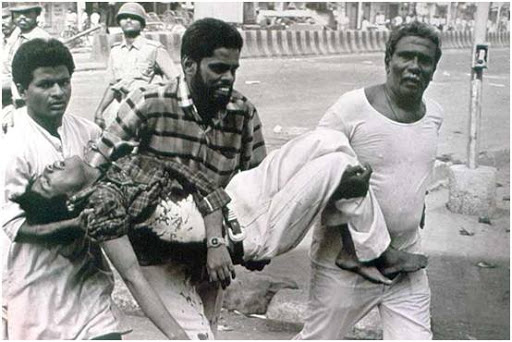By Tazeen Junaid
On 13 August 1980, Moradabad police indiscriminately opened fire on thousands of namazis (worshippers) in the Eidgah, killing hundreds of them, many of them children. A straight comparison can be drawn with the Jallianwala Bagh massacre when a British officer, named General Dyer fired on unarmed civilians who had gathered in Jallianwala Bagh to celebrate Vaisakhi. However, unlike the Jallianwala Bagh, the persecution of Muslims didn’t stop there.
Soon afterwards, Uttar Pradesh Provincial Armed Constabulary (PAC), renowned for its anti-Muslim bias was stationed at Moradabad. A teenage witness, staying at the camp of Central Police Forces, adjacent to the PAC camp testifies that the police opened fire at Muslims. Hundreds accused of rioting, who included only Muslims, were rounded up by PAC, brought to the PAC campus and beaten as soon as they got down from buses. In some cases, the beatings had already begun in the buses. They were beaten so severely that most of them were drenched in blood after walking just a few meters from the buses. Many people lost consciousness in the PAC camp and many might have died too. There was not any way then and there is no way now of knowing the truth.
During the three months of continuing curfew, nearly 2500 people died in Moradabad. Official figures only list 400 as dead. But many went missing also. There is no record of the missing with either the police or the PAC.
Naseem lost his father, a wealthy brassware manufacturer, to PAC. PAC entered their house, beat his father and took him away in a jeep. The family searched for him, met officials and visited jails. Even today, Naseem doesn’t know whether he should pray for his father’s afterlife or his safe return. What’s worse? The fact that so many died and went missing? Or those who are left behind do not know what to do.
The most troubling incident is that of the missing dead bodies. Alam’s mother died because a tear gas shell landed inside their house. They kept the body in the house for three days. District administration took the body and never returned it, perhaps because it documented unjust persecution of Muslim neighbourhoods.
Moradabad’s world-famous brass manufacturers, mostly Muslims, lost their market share during these months. Riots and curfews ruined the thriving economy of Moradabad.
Later on, many newspapers tried to shift the blame on communal tendencies of Muslims by claiming that Muslims were armed and also published fake pieces on Border Security Forces (BSF) personnel who were killed or went missing. If it was not for MP Syed Shahabuddin or ironically enough a BJP member, MJ Akbar, we would not have even known this.
As we finish 40 years from that deadly day, there exists little to no institutional memory of that one-sided police attack on Muslims, and the cover-up dealt by leading newspapers and weeklies then, including Economic and Political Weekly.
My house is in Moradabad. I have seen my neighbours, both Muslims and non-Muslims grieving in the ghettoized Muslim neighbourhoods. Many might be grieving today too, waiting for justice, waiting for dead bodies, waiting for their fathers and brothers. Many are just waiting for news, for some piece of information. They are just waiting to end their wait. They are still waiting for justice but will justice come to Muslims today, in this India which has strayed far away from secularism? Will their wait end?
Tazeen Junaid is a Bachelors student at Aligarh Muslim University (AMU).

